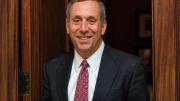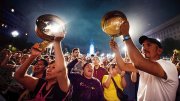As a president twice, and adviser to many other university leaders, Lawrence S. Bacow says he often counsels them that their second year in office, after the honeymoon, is often the toughest. That was true for his predecessor, Drew Gilpin Faust, who set about making plans for Harvard’s future, only to run head-on into the Great Recession, a decimated endowment, and years of austerity and dreams deferred. She in turn reminded Bacow that the coronavirus’s surge during his second year overturned every aspect of the University’s academic life: not just finances, but in-person teaching, residence on campus, research, travel, and more.
During a conversation last Friday, March 5—exactly 51 weeks after campus operations ceased, students, faculty, and staff dispersed, and Bacow himself held his last meeting in Mass Hall—he spoke with warm enthusiasm about the things the entire community had managed to do well nonetheless. He put into perspective how the academic mission has proceeded, online and otherwise: gains realized, often unheeded, amid the basic worries about everyone’s health and their losses associated with the pandemic, unnatural distancing of people from one another, and nine-figure declines in Harvard revenues. If COVID-19 upended the last third of Bacow’s sophomore year as president, it has dominated his third. Given the history of a 385-year-old institution that has withstood plenty, he is looking over the horizon to what comes next—including sweeping changes in education, on campus and far beyond.
What Moved Forward
• Allston. During the academic year, the University has become a bigger place. Bacow noted that many engineering and applied-sciences (SEAS) faculty members have moved their laboratories into the new science and engineering center in Allston. So it is operating, even though the pandemic has deferred its inaugural use for teaching—and kept community members from seeing inside “one of the most extraordinary buildings” on campus. (Updated March 17, 21021, 12:40 p.m.: The building has received LEED platinum certification, as reported here.) Less visibly, the “enterprise research campus” farther east toward the Charles River is progressing—with construction on the initial hotel, conference center, office/lab towers, and apartments to begin perhaps next year. Bacow said companies had shown “a lot of interest” in the plans and prospective proximity both to the SEAS and Harvard Business School faculties, and to the cluster of Innovation Labs. (Plans for a successor, million-square-foot development phase are taking shape, too.) And work continues—Bacow was meeting that afternoon with Diane Paulus, artistic director of the American Repertory Theater, and her architect on plans for the ART’s future home, which will rise along North Harvard Street. [Updated March 8, 2021, 3:00 p.m.: The meeting on the plans for the new ART facility in fact is now scheduled to take place this week.]
• Emerging academic agendas. Bacow also cited progress on University academic programs, such as the quantum-science initiative. Last Tuesday, the Faculty of Arts and Sciences (FAS) considered a proposal for a new Ph.D. program—the coin of the realm in a research university—in quantum science and engineering. It envisions melding elements of physics, applied physics, electrical engineering, chemistry, and computer science in a new discipline, with new courses, matriculating a half-dozen doctoral students annually (building to a cohort of 36 in residence)—and even including a couple of new faculty members, now being recruited (at a time of extraordinary controls on such hiring across the University) to join the existing 40 or so professors who already work in these fields. There may be more news about quantum science in coming weeks, as FAS is scheduled to vote on the proposal at its April meeting.
Bacow alluded as well to comparable developments in fields ranging from climate change to inequality. And he pointed to continued, robust momentum in life sciences, ranging from announcement of the Harvard-anchored Center for Advanced Biological Innovation and Manufacturing (a shared facility for nascent cell-manufacturing and other technologies and enterprises), to plans to further develop efforts against new biomedical challenges by the collaborative Massachusetts Consortium on Pathogen Readiness (assembled around the Medical School to combat the coronavirus). He also hailed the role of the research entities in which Harvard is a partner: the Broad Institute for deploying COVID-19 testing on a massive scale that served “all of higher education in New England”—a powerful advantage in maintaining safe campus operations when compared to testing capacity in other parts of the country; and the Ragon Institute for its research on the persistence of antibodies after COVID-19 infections—a study in which Bacow himself and his wife, Adele, are enrolled. Across the board, Bacow said, “I’m really, really proud of how folks have responded.
(It will be interesting to see how these promising developments, forged under the acute pressure of the pandemic and the longer-term growth of academic and commercial life sciences in Greater Boston, evolve. As the Chan Zuckerberg Initiative has invested in West Coast life-sciences capabilities with its CZI Biohub, linking Berkeley, Stanford, and University of California San Francisco, one senses Boston’s proudly independent universities, academic medical centers, and research institutes taking steps toward self-assembling similar partnerships and entities to create shared facilities and complementary expertise.)
The president also had a gift to celebrate: the announcement during the week of a $150-million commitment from Bloomberg Philanthropies to extend the Bloomberg Harvard City Leadership Initiative, a program that offers training for mayors across the country. Former New York City mayor Michael R. Bloomberg, M.B.A. ’66, LL.D. ’14, and Bacow explained the extended venture and its prospective impact on improved governance in a Boston Globe op-ed on March 3. From the University perspective, the work is also, helpfully, anchored by a new University-wide center, based in the Kennedy School, accompanied by funds for 10 new professorships.
• Teaching and learning. Generalizing from these experiences, Bacow said that Harvard has traditionally been seen as a slow, even lumbering institution, reluctant to adapt to change and often hampered in doing so by its highly decentralized organization. The past year, he continued, had put much of that characterization to rest. The initial pivot to online learning, he noted, had been effected in less than two weeks, and the faculties have since learned a great deal about such teaching. The schools, with very different operations and economics, have adapted their budgets rapidly—in face of daunting projections of revenue losses of as much as $700 million across Harvard during the fiscal year ending this June 30. “Everybody has pulled together,” he said. “People have been creative” in managing resources and conducting academic operations under unprecedented circumstances.
For example, he said, instruction in laboratory classes has been maintained, even with students dispersed around the world. In some cases materials and equipment for experiments were shipped to their homes; in others, exercises were devised that they could conduct in their local environments (for example, gathering data based on the weather). Virtual laboratories had even made it possible to conduct “experiments” that could not be run safely in a laboratory, or indeed any real setting: students could in effect “blow stuff up,” Bacow said, by modeling explosive or destructive outcomes. Expect those tools and techniques to be brought back to campus for application when residential instruction resumes. The faculty as a whole, he said, have been “unbelievably creative” in redesigning courses.
He cited similar examples of ingenuity outside degree programs, and indeed beyond instruction proper. The Graduate School of Education, for example, deployed teaching and learning materials for K-12 students and their parents, confronted with learning from home. Public-health associate professor Joseph Allen, director of the Healthy Buildings Program—an expert on indoor air quality, a critical subject during the pandemic—created an online course in three weeks, and reached 30,000-plus users: an instance, Bacow said, of how Harvard faculty members can “reach out and touch lots and lots of people” they would not be teaching otherwise. Extracurricularly, Phillips Brooks House Association found ways to rechannel undergraduate volunteers to help parents and students via virtual tutoring.
As for the minority of undergraduates who have been in residence during the academic year, Bacow confessed to initial skepticism about their willingness to comply with Harvard’s rigorous testing, masking, social distancing, and other health protocols. They have risen to the challenges, he said—COVID-19 infections in the community have been de minimis (59 undergraduate positive cases since last June 1, when testing data were first posted to the Harvard coronavirus dashboard)—making him proud of their exemplary behavior.
What’s in Prospect Post-Pandemic
Based on his overview of a year of transformed instruction, Bacow said, “I think our students are going to have a greatly enhanced in-class and co-curricular experience” when normal campus operations resume. It will be much easier, and completely natural, to “import” guests into class settings digitally, broadening the range of such visiting lecturers and speakers compared to the prior constraints of time and travel cost. And, he noted, lots of people have wanted to come to Harvard to engage with students: “We’d love to have had them,” he said, and “they’d love to be here.” Now, far more can be accommodated online, complementing those who will still appear in person. enriching education in subjects spanning the liberal-arts and professional, experience-based curriculums.
Looking outward, he cited the Graduate School of Education’s successful experiment with making its one-year master’s degree available remotely, over a two-year period, thus accommodating a vastly wider range of matriculants who found they could suddenly take a degree while maintaining their employment—and avoiding the cost of moving to and living in Cambridge. The University, Bacow said, would now “take a long, hard look” at enabling such nonresidential degree opportunities “for a lot of the schools that have one-year professional master’s programs,” including those of design, engineering and applied sciences, government, law, and public health in addition to education. Decisions on such outreach are up to each school—but their experiences during the past year have “shortened the learning curve,” Bacow said. Permitting degree programs with out-of-term-time residence (perhaps complemented by summer- or winter-session immersions on campus) would seem to represent a significant opportunity to expand Harvard’s enormous, strategically and financially important extension and professional continuing-education programs; they had been growing vigorously, to annual revenues of $500 million, until the pandemic quashed travel and in-person teaching.
A third change may be the rise of online office hours. Students appear “far more likely to engage” with faculty members outside the classroom via Zoom, he said, than via in-person appointments. Whether this is an artifact of the mandatory distancing, from campus and one another, during the past three semesters remains to be seen, but indications are that online meetings of this sort are popular, and work.
As for Harvard’s employees—faculty and staff members—more flexible working arrangements seem certain. It is too soon to know how exactly that will play out, Bacow noted, but flexible work schedules (and less gridlocked Boston-area commuting) of some sort is clearly in the cards.
But none of these trends, he insisted, would alter a core characteristic: the Harvard College experience will remain a residential one. It may be enhanced—by those prospective online classroom visitors, for instance, or by innovative arrangements enabling groups of students to travel for term-time field-course experiences while continuing their classes online in the interim—but the essence of undergraduate life and learning will be squarely centered around campus.
Welcome back to Harvard Yard, everyone—soon.








